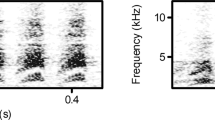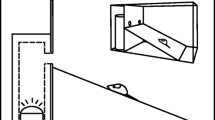Summary
The behaviour of 514 juvenile Willow Tits (Parus montanus) was recorded during four phases of the capture/ringing procedure: (1) when seized in the trap by hand, (2) when held in the hand, (3) during flight after release and (4) after perching in tree. During phase 1, 79% of the tits kept silent, while the remaining birds mostly gave distress calls (screamed or hissed). When held in the hand 67% kept silent, while 98% of the remainder uttered distress calls. The survival value of distress calls in this context seems dubious, they may merely express fear.Spitt alertness calls (often combined withtää-notes) andsit foraging calls were those most frequently given during flight.Sisi alarm andtää calls predominated after perching in tree. During phases 1–3 a larger proportion of the males kept silent than of the females.
Zusammenfassung
Verhalten und Lautäußerungen von 514 jungen Weidenmeisen (Parus montanus) während Beringung und nach ihrer Freilassung werden beschrieben. Vier Phasen wurden unterschieden: (1) Vogel in der Falle gegriffen, (2) Vogel in der Hand, (3) nach Freilassung und (4) unmittelbar nach Erreichen nahegelegener Bäume oder Büsche. Während Phase 1 waren 79% der Vögeln stumm, die übrigen äußerten vor allem Notrufe (Zischen oder Schreie; Abb. 1a). In der Hand schwiegen 67% der Meisen; von den übrigen äußerten 98% Notrufe. Die biologische Bedeutung der Notrufe in diesem Zusammenhang ist zweifelhaft; vielleicht sind sie nur ein Ausdruck von Furcht.Spitt Erregungsrufe, öfter mitdäh Elementen kombiniert (Abb. 1c), und leisesit Rufe (Abb. 1f), die Nahrungssuche charakterisieren, waren die hauptsächlichen Laute im Flug.Sisi Alarmrufe (Abb. 1b) unddäh-Rufe dominierten die Äußerungen, sobald sich die Vögel in einem Baum oder Busch befanden. Männchen schwiegen während der Phasen 1–3 häufiger als Weibchen.
Similar content being viewed by others
References
Apel, K. M. & Weise, C. M. (1986). The hiss-display of nestling Black-capped Chickadees in captivity. Wilson Bull. 98: 320–321.
Bastian, A. & Bastian, H.-V. (1990): Rufe beringter Vögel nach ihrer Freilassung. J. Ornithol. 131: 361–369.
Ekman, J. (1979). Coherence, composition and territories of winter social groups of the Willow TitParus montanus and the Crested TitP. cristatus. Ornis Scand. 10: 56–68.
Haftorn, S. (1993): Ontogeny of the vocal repertoire in the Willow TitParus montanus. Ornis Scand. 24: 267–289.
Haftorn, S. (1997): Natal dispersal and winter flock formation in the Willow TitParus montanus. Fauna norv. Ser. C, Cinclus 20: 17–35.
Haftorn, S. (1998): Flock formation, flock size and flock persistence in the Willow TitParus montanus. Ornis Fenn. 75 (in press).
Hill, G. E. (1986): The function of distress calls given by tufted titmice (Parus bicolor): an experimental approach. Anim. Behav. 34: 590–598.
Ingold, J. L. (1988): Release calls of mist-netted birds. J. Field Ornithol. 59: 227–234.
Ludescher, F. B. (1973). Sumpfmeise (Parus palustris L.) und Weidenmeise (P. montanus salicarius Br.) als sympatrische Zwillingsarten. J. Ornithol. 114: 3–56.
Matthysen, E. & Dhondt, A. A. (1988): Behaviour of birds after release from capture as an indicator of territorial status. Ibis 130: 69–72.
Thönen, W. (1962): Stimmgeographische, ökologische und verbreitungsgeschichtliche Studien über die Mönchsmeise (Parus montanus Conrad). Orn. Beob. 59: 101–172.
Author information
Authors and Affiliations
Corresponding author
Rights and permissions
About this article
Cite this article
Haftorn, S. Calls by Willow Tits (Parus montanus) during ringing and after release. J. Ornithol. 140, 51–56 (1999). https://doi.org/10.1007/BF02462088
Accepted:
Published:
Issue Date:
DOI: https://doi.org/10.1007/BF02462088




